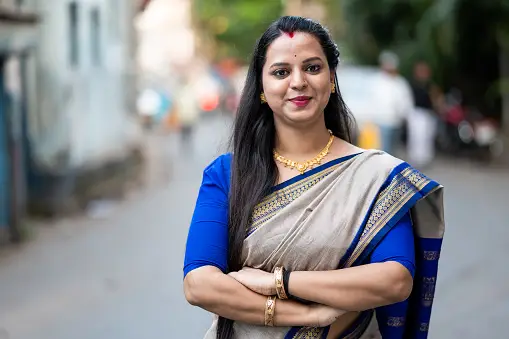
Top 10 Facts About Sari In Indian Culture? The sari is a quintessential garment in Indian culture, embodying grace, elegance, and tradition. This versatile piece of clothing has a rich history and holds significant cultural value. In this article, we will explore the top 10 facts about the sari, shedding light on its origins, diversity, and significance in Indian society.
The Origin of the Sari
The sari traces its roots back to ancient India, with references dating back to 2800-1800 BCE. The word “sari” is derived from the Sanskrit word “sati,” meaning a strip of cloth. Initially, saris were worn as a simple garment to cover the body, but over time, they became an emblem of Indian femininity and tradition.
Evolution of Sari Styles
Over centuries, the sari has evolved in terms of design, draping styles, and motifs. Different regions of India have their own distinct sari styles, such as the Banarasi silk saris, Kanjeevaram silk saris, and Bandhani saris. Each style showcases unique craftsmanship and reflects the cultural heritage of the respective region.
Fabrics Used in Sari Making

A wide range of fabrics is used to create saris, including silk, cotton, chiffon, georgette, and crepe. Each fabric has its own distinct texture, drape, and feel. The choice of fabric depends on the occasion, climate, and personal preference of the wearer.
Draping Techniques
Draping a sari is an art form in itself, with numerous draping techniques prevalent across India. The most common style is the Nivi drape, where the sari is wrapped around the waist, pleated, and draped over the shoulder. Other styles include the Gujarati drape, Bengali drape, and Maharashtrian drape, each showcasing unique variations in pleating and pallu placement.
Regional Variations of Sari

India’s diverse culture gives rise to a wide array of regional sari styles. From the vibrant Bandhani saris of Rajasthan to the intricate Kanjeevaram silk saris of Tamil Nadu, each region has its own distinct weaving patterns, motifs, and color palettes. These regional variations highlight the richness and diversity of Indian textile traditions.
Read More: The Benefits of Wireless Networks In 2023
Symbolism in Sari Designs

Sari designs often carry symbolic meanings. Intricate motifs and patterns, such as peacocks, lotus flowers, and traditional paisley designs, can represent fertility, prosperity, or cultural heritage. These designs not only enhance the aesthetic appeal of the sari but also convey stories and traditions from generations past.
Occasions and Significance

Saris are worn on various occasions and hold significant cultural value in Indian society. They are commonly seen during festivals, weddings, and religious ceremonies. The choice of sari for a particular occasion can convey social status, marital status, and regional identity.
Sari in Bollywood
The sari has played a prominent role in Bollywood films, becoming an iconic symbol of Indian cinema. Actresses draped in elegant saris have captured the hearts of millions worldwide. Bollywood has popularized various sari styles and designs, making them fashionable not only in India but across the globe.
Sari in Modern Fashion
While deeply rooted in tradition, the sari has also adapted to modern fashion trends. Contemporary designers experiment with innovative draping styles, fusion ensembles, and unconventional fabric choices to create unique sari interpretations. This fusion of traditional and modern elements has brought the sari into the realm of high fashion.
Global Influence of the Sari

The sari’s influence extends beyond India’s borders. It has gained recognition as a sophisticated and elegant garment in the global fashion industry. International designers have incorporated elements of the sari into their collections, showcasing its timeless beauty and cultural significance on international runways.
Conclusion
The sari holds a cherished place in Indian culture, representing the beauty, tradition, and diversity of the country. Its intricate designs, regional variations, and timeless appeal continue to captivate people worldwide. Whether worn during special occasions or embraced as a fashion statement, the sari remains an enduring symbol of Indian heritage.
FAQs
Can men wear saris in Indian culture?
While saris are primarily worn by women in Indian culture, men may wear a similar garment known as a dhoti, which is a rectangular piece of cloth draped around the waist.
Are saris only worn for formal occasions?
Saris are worn for various occasions, ranging from formal events like weddings and festivals to everyday wear. The choice of sari depends on the context and personal preference.
How do you maintain and care for a sari?
Saris should be gently hand-washed or dry cleaned, depending on the fabric. It is important to follow the care instructions provided by the manufacturer to maintain the sari’s quality and color.
Can non-Indians wear saris?
Yes, non-Indians are welcome to embrace and wear saris. It is seen as a respectful appreciation of Indian culture and can be a way to celebrate diversity and cross-cultural exchange.
Are there specific saris associated with particular Indian states?
Yes, different Indian states have their own unique sari styles associated with their cultural heritage and traditional weaving techniques. Examples include the Kanjeevaram saris of Tamil Nadu and the Chanderi saris of Madhya Pradesh.












2 Comments